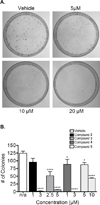Melampodium leucanthum, a source of cytotoxic sesquiterpenes with antimitotic activities
- PMID: 25685941
- PMCID: PMC4749154
- DOI: 10.1021/np500768s
Melampodium leucanthum, a source of cytotoxic sesquiterpenes with antimitotic activities
Abstract
A new tricyclic sesquiterpene, named meleucanthin (1), was isolated from an extract of the leaves and branches of Melampodium leucanthum, along with four known germacranolide sesquiterpene lactones, leucanthin-A (2), leucanthin-B (3), melampodin-A acetate (4), and 3α-hydroxyenhydrin (5). The chemical structure of 1 was elucidated by analysis of 1D and 2D NMR and mass spectrometric data. All compounds exhibited antiproliferative and cytotoxic efficacy against PC-3 and DU 145 prostate cancer cells, as well as HeLa cervical cancer cells, with IC50 values ranging from 0.18 to 9 μM. These compounds were effective in clonogenic assays and displayed high cellular persistence. They were also found to be capable of circumventing P-glycoprotein-mediated drug resistance. Mechanism of action studies showed that 4 caused an accumulation of cells in the G2/M phase of the cell cycle, and 2-5 caused the formation of abnormal mitotic spindles. These results suggest the cytotoxic effects of these germacranolides involve inhibition of mitotic spindle function, and it is likely that other mechanisms additionally contribute to cell death. These studies also demonstrate the possibility of isolating new, biologically active compounds from indigenous Texas plants.
Figures








Similar articles
-
A new norsesquiterpenoid from Ligularia virgaurea.J Asian Nat Prod Res. 2015;17(4):415-9. doi: 10.1080/10286020.2014.971018. Epub 2014 Nov 3. J Asian Nat Prod Res. 2015. PMID: 25363682
-
Cytotoxic sesquiterpene lactones from Pseudoelephantopus spicatus.J Nat Prod. 2007 Nov;70(11):1761-5. doi: 10.1021/np070331q. Epub 2007 Oct 31. J Nat Prod. 2007. PMID: 17970595
-
Sesquiterpene lactones from Gonospermum gomerae and G. fruticosum and their cytotoxic activities.J Nat Prod. 2008 Dec;71(12):2015-20. doi: 10.1021/np800474v. J Nat Prod. 2008. PMID: 19053514
-
Emerging Anti-Mitotic Activities and Other Bioactivities of Sesquiterpene Compounds upon Human Cells.Molecules. 2017 Mar 13;22(3):459. doi: 10.3390/molecules22030459. Molecules. 2017. PMID: 28335397 Free PMC article. Review.
-
An insight into cytotoxic activity of flavonoids and sesquiterpenoids from selected plants of Asteraceae species.Chem Biol Drug Des. 2021 Dec;98(6):1116-1130. doi: 10.1111/cbdd.13970. Epub 2021 Oct 26. Chem Biol Drug Des. 2021. PMID: 34626448 Review.
Cited by
-
Natural sesquiterpene lactones in prostate cancer therapy: mechanisms and sources.Med Oncol. 2025 May 15;42(6):212. doi: 10.1007/s12032-025-02740-2. Med Oncol. 2025. PMID: 40372575 Review.
-
Texas Native Plants Yield Compounds with Cytotoxic Activities against Prostate Cancer Cells.J Nat Prod. 2016 Mar 25;79(3):531-40. doi: 10.1021/acs.jnatprod.5b00908. Epub 2016 Jan 19. J Nat Prod. 2016. PMID: 26785306 Free PMC article.
-
Sesquiterpenoid lactones as potential anti-cancer agents: an update on molecular mechanisms and recent studies.Cancer Cell Int. 2022 Oct 7;22(1):305. doi: 10.1186/s12935-022-02721-9. Cancer Cell Int. 2022. PMID: 36207736 Free PMC article. Review.
-
Regulation of E-cadherin localization by microtubule targeting agents: rapid promotion of cortical E-cadherin through p130Cas/Src inhibition by eribulin.Oncotarget. 2017 Dec 31;9(5):5545-5561. doi: 10.18632/oncotarget.23798. eCollection 2018 Jan 19. Oncotarget. 2017. PMID: 29464017 Free PMC article.
-
Antiproliferative and cytotoxic activity of Geraniaceae plant extracts against five tumor cell lines.Future Sci OA. 2021 Dec 3;8(2):FSO775. doi: 10.2144/fsoa-2021-0109. eCollection 2022 Feb. Future Sci OA. 2021. PMID: 35070357 Free PMC article.
References
-
- Siegel R, Ma J, Zou Z, Jemal A. CA Cancer J. Clin. 2014;64:9–29. - PubMed
-
- Kirby M, Hirst C, Crawford ED. Int. J. Clin. Pract. 2011;65:1180–1192. - PubMed
-
- Cookson MS, Roth BJ, Dahm P, Engstrom C, Freedland SJ, Hussain M, Lin DW, Lowrance WT, Murad MH, Oh WK, Penson DF, Kibel AS. J. Urol. 2013;190:429–438. - PubMed
-
- Hwang SS, Chang VT, Alejandro Y, Mulaparthi S, Cogswell J, Srinivas S, Kasimis B. Cancer. Invest. 2004;22:849–857. - PubMed
-
- Soerdjbalie-Maikoe V, Pelger RC, Lycklama a Nijeholt GA, Arndt JW, Zwinderman AH, Bril H, Papapoulos SE, Hamdy NA. Eur. J. Nucl. Med. Mol. Imaging. 2004;31:958–963. - PubMed
Publication types
MeSH terms
Substances
Grants and funding
LinkOut - more resources
Full Text Sources
Other Literature Sources

